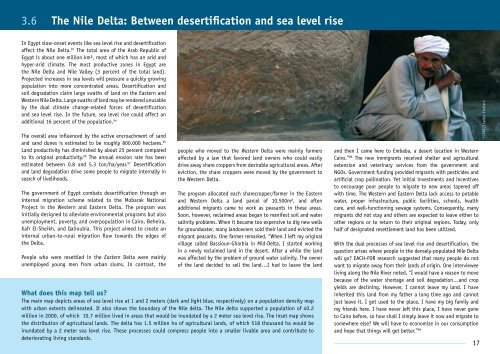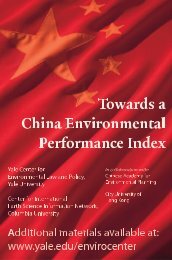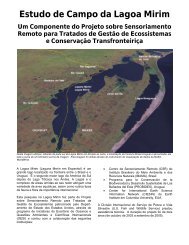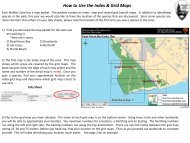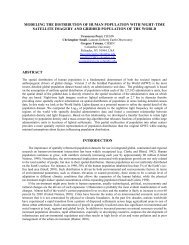In Search of Shelter - Center for International Earth Science ...
In Search of Shelter - Center for International Earth Science ...
In Search of Shelter - Center for International Earth Science ...
You also want an ePaper? Increase the reach of your titles
YUMPU automatically turns print PDFs into web optimized ePapers that Google loves.
3.6 The Nile Delta: Between desertification and sea level rise<strong>In</strong> Egypt slow-onset events like sea level rise and desertificationaffect the Nile Delta. 93 The total area <strong>of</strong> the Arab Republic <strong>of</strong>Egypt is about one million km², most <strong>of</strong> which has an arid andhyper-arid climate. The most productive zones in Egypt arethe Nile Delta and Nile Valley (3 percent <strong>of</strong> the total land).Projected increases in sea levels will pressure a quickly growingpopulation into more concentrated areas. Desertification andsoil degradation claim large swaths <strong>of</strong> land on the Eastern andWestern Nile Delta. Large swaths <strong>of</strong> land may be rendered unusableby the dual climate change-related <strong>for</strong>ces <strong>of</strong> desertificationand sea level rise. <strong>In</strong> the future, sea level rise could affect anadditional 16 percent <strong>of</strong> the population. 94The overall area influenced by the active encroachment <strong>of</strong> sandand sand dunes is estimated to be roughly 800,000 hectares. 95Land productivity has diminished by about 25 percent comparedto its original productivity. 96 The annual erosion rate has beenestimated between 0.8 and 5.3 ton/ha/year. 97 Desertificationand land degradation drive some people to migrate internally insearch <strong>of</strong> livelihoods.The government <strong>of</strong> Egypt combats desertification through aninternal migration scheme related to the Mobarak NationalProject in the Western and Eastern Delta. The program wasinitially designed to alleviate environmental programs but alsounemployment, poverty, and overpopulation in Cairo, Beheira,Kafr El-Sheikh, and Qalioubia. This project aimed to create aninternal urban-to-rural migration flow towards the edges <strong>of</strong>the Delta.People who were resettled in the Eastern Delta were mainlyunemployed young men from urban slums. <strong>In</strong> contrast, thepeople who moved to the Western Delta were mainly farmersaffected by a law that favored land owners who could easilydrive away share croppers from desirable agricultural areas. Aftereviction, the share croppers were moved by the government tothe Western Delta.The program allocated each sharecropper/farmer in the Easternand Western Delta a land parcel <strong>of</strong> 10,500m², and <strong>of</strong>tenadditional migrants came to work as peasants in these areas.Soon, however, reclaimed areas began to manifest soil and watersalinity problems. When it became too expensive to dig new wells<strong>for</strong> groundwater, many landowners sold their land and evicted themigrant peasants. One farmer remarked, “When I left my originalvillage called Bassioun-Gharbia in Mid-Delta, I started workingin a newly reclaimed land in the desert. After a while the landwas affected by the problem <strong>of</strong> ground water salinity. The owner<strong>of</strong> the land decided to sell the land…I had to leave the landWhat does this map tell us?The main map depicts areas <strong>of</strong> sea level rise at 1 and 2 meters (dark and light blue, respectively) on a population density mapwith urban extents delineated. It also shows the boundary <strong>of</strong> the Nile delta. The Nile delta supported a population <strong>of</strong> 40.2million in 2000, <strong>of</strong> which 10.7 million lived in areas that would be inundated by a 2 meter sea level rise. The inset map showsthe distribution <strong>of</strong> agricultural lands. The delta has 1.5 million ha <strong>of</strong> agricultural lands, <strong>of</strong> which 518 thousand ha would beinundated by a 2 meter sea level rise. These processes could compress people into a smaller livable area and contribute todeteriorating living standards.and then I came here to Embaba, a desert location in WesternCairo.” 98 The new immigrants received shelter and agriculturalextension and veterinary services from the government andNGOs. Government funding provided migrants with pesticides andartificial crop pollination. Yet initial investments and incentivesto encourage poor people to migrate to new areas tapered <strong>of</strong>fwith time. The Western and Eastern Delta lack access to potablewater, proper infrastructure, public facilities, schools, healthcare, and well-functioning sewage systems. Consequently, manymigrants did not stay and others are expected to leave either toother regions or to return to their original regions. Today, onlyhalf <strong>of</strong> designated resettlement land has been utilized.With the dual processes <strong>of</strong> sea level rise and desertification, thequestion arises where people in the densely-populated Nile Deltawill go? EACH-FOR research suggested that many people do notwant to migrate away from their lands <strong>of</strong> origin. One intervieweeliving along the Nile River noted, “I would have a reason to movebecause <strong>of</strong> the water shortage and soil degradation…and cropyields are declining. However, I cannot leave my land. I haveinherited this land from my father a long time ago and cannotjust leave it. I got used to the place, I have my big family andmy friends here. I have never left this place, I have never goneto Cairo be<strong>for</strong>e, so how shall I simply leave it now and migrate tosomewhere else? We will have to economize in our consumptionand hope that things will get better.” 9917©CARE/Charles Ehrhart


